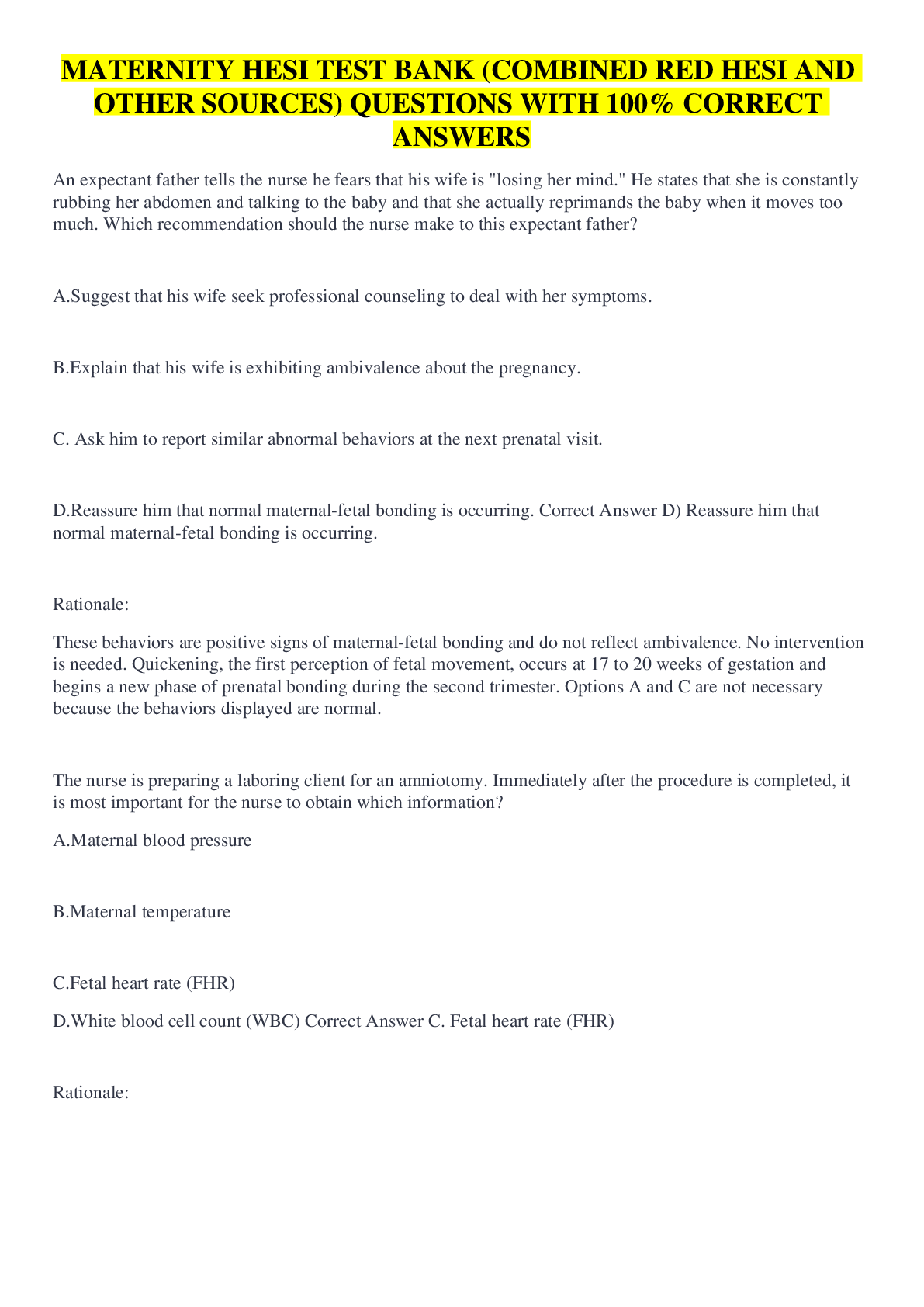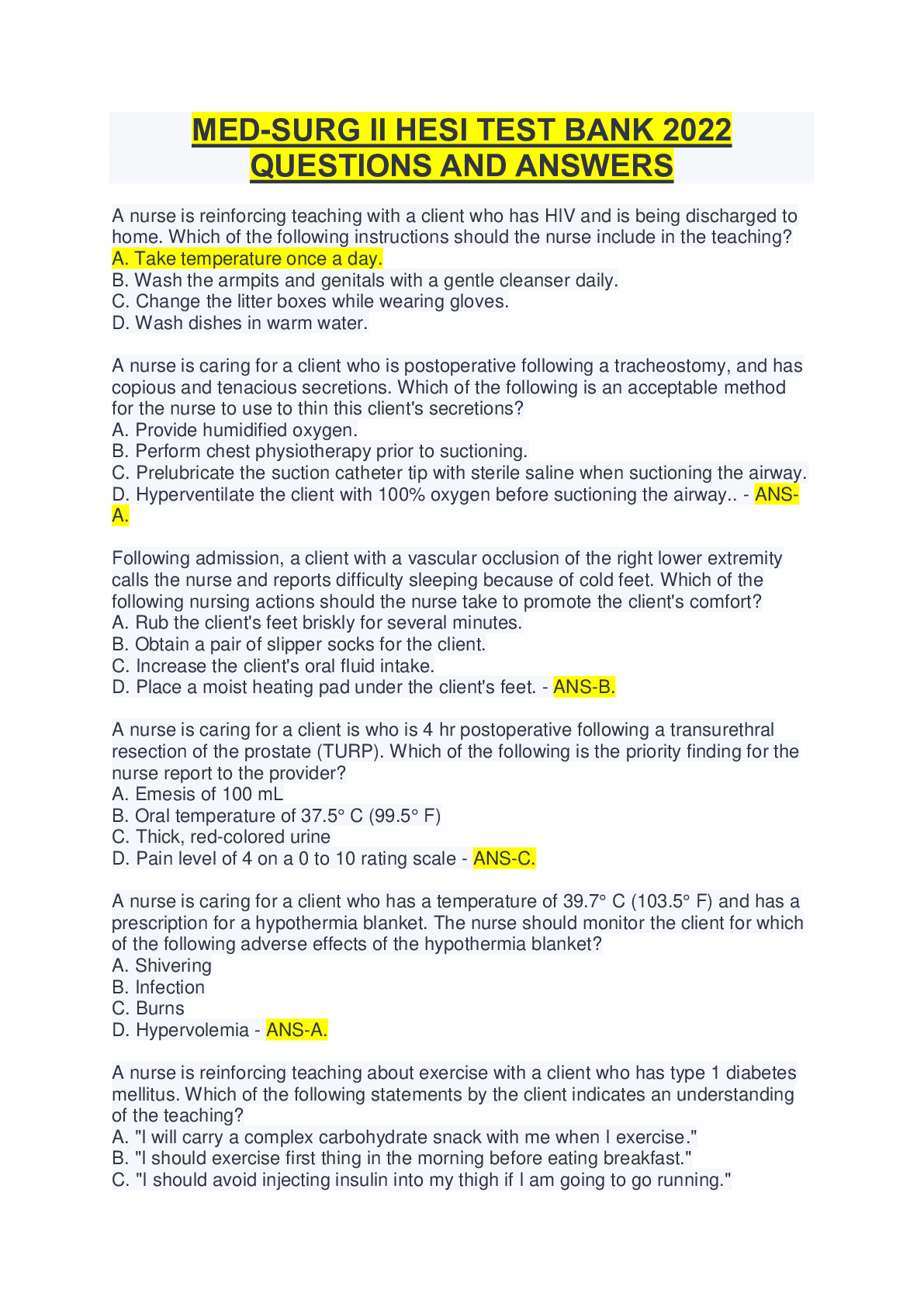*NURSING > QUESTIONS & ANSWERS > Med Surg Test bank (Red HESI Test bank Med-Surg and other resources) with Verified Solutions (All)
Med Surg Test bank (Red HESI Test bank Med-Surg and other resources) with Verified Solutions
Document Content and Description Below
Med Surg Test bank (Red HESI Test bank Med-Surg and other resources) with Verified Solutions The nurse assesses a patient with shortness of breath for evidence of long-standing hypoxemia by inspect... ing: A. Chest excursion B. Spinal curvatures C. The respiratory pattern D. The fingernail and its base ✔Ans✔ D. The fingernail and its base Clubbing, a sign of long-standing hypoxemia, is evidenced by an increase in the angle between the base of the nail and the fingernail to 180 degrees or more, usually accompanied by an increase in the depth, bulk, and sponginess of the end of the finger. 2. The nurse is caring for a patient with COPD and pneumonia who has an order for arterial blood gases to be drawn. Which of the following is the minimum length of time the nurse should plan to hold pressure on the puncture site? A. 2 minutes B. 5 minutes C. 10 minutes D. 15 minutes ✔Ans✔ B. 5 minutes Following obtaining an arterial blood gas, the nurse should hold pressure on the puncture site for 5 minutes by the clock to be sure that bleeding has stopped. An artery is an elastic vessel under higher pressure than veins, and significant blood loss or hematoma formation could occur if the time is insufficient. 3. The nurse notices clear nasal drainage in a patient newly admitted with facial trauma, including a nasal fracture. The nurse should: A. test the drainage for the presence of glucose. B. suction the nose to maintain airway clearance. C. document the findings and continue monitoring. D. apply a drip pad and reassure the patient this is normal. ✔Ans✔ A. test the drainage for the presence of glucose. Clear nasal drainage suggests leakage of cerebrospinal fluid (CSF). The drainage should be tested for the presence of glucose, which would indicate the presence of CSF. 4. When caring for a patient who is 3 hours postoperative laryngectomy, the nurse's highest priority assessment would be: A. Airway patency B. Patient comfort C. Incisional drainage D. Blood pressure and heart rate ✔Ans✔ A. Airway patency Remember ABCs with prioritization. Airway patency is always the highest priority and is essential for a patient undergoing surgery surrounding the upper respiratory system. 5. When initially teaching a patient the supraglottic swallow following a radical neck dissection, with which of the following foods should the nurse begin? A. Cola B. Applesauce C. French fries D. White grape juice ✔Ans✔ A. ColaWhen learning the supraglottic swallow, it may be helpful to start with carbonated beverages because the effervescence provides clues about the liquid's position. Thin, watery fluids should be avoided because they are difficult to swallow and increase the risk of aspiration. Nonpourable pureed foods, such as applesauce, would decrease the risk of aspiration, but carbonated beverages are the better choice to start with. 6. The nurse is caring for a patient admitted to the hospital with pneumonia. Upon assessment, the nurse notes a temperature of 101.4° F, a productive cough with yellow sputum and a respiratory rate of 20. Which of the following nursing diagnosis is most appropriate based upon this assessment? A. Hyperthermia related to infectious illness B. Ineffective thermoregulation related to chilling C. Ineffective breathing pattern related to pneumonia D. Ineffective airway clearance related to thick secretions ✔Ans✔ A. Hyperthermia related to infectious illness Because the patient has spiked a temperature and has a diagnosis of pneumonia, the logical nursing diagnosis is hyperthermia related to infectious illness. There is no evidence of a chill, and her breathing pattern is within normal limits at 20 breaths per minute. There is no evidence of ineffective airway clearance from the information given because the patient is expectorating sputum. 7. Which of the following physical assessment findings in a patient with pneumonia best supports the nursing diagnosis of ineffective airway clearance? A. Oxygen saturation of 85% B. Respiratory rate of 28 C. Presence of greenish sputum D. Basilar crackles ✔Ans✔ D. Basilar crackles The presence of adventitious breath sounds indicates that there is accumulation of secretions in the lower airways. This would be consistent with a nursing diagnosis of ineffective airway clearance because the patient is retaining secretions. 8. Which of the following clinical manifestations would the nurse expect to find during assessment of a patient admitted with pneumococcal pneumonia? A. Hyperresonance on percussion B. Fine crackles in all lobes on auscultation C. Increased vocal fremitus on palpation D. Vesicular breath sounds in all lobes ✔Ans✔ C. Increased vocal fremitus on palpation. A typical physical examination finding for a patient with pneumonia is increased vocal fremitus on palpation. Other signs of pulmonary consolidation include dullness to percussion, bronchial breath sounds, and crackles in the affected area. 9. Which of the following nursing interventions is of the highest priority in helping a patient expectorate thick secretions related to pneumonia? A. Humidify the oxygen as able B. Increase fluid intake to 3L/day if tolerated. C. Administer cough suppressant q4hr. D. Teach patient to splint the affected area. ✔Ans✔ B. Increase fluid intake to 3L/day if tolerated. Although several interventions may help the patient expectorate mucus, the highest priority should be on increasing fluid intake, which will liquefy the secretions so that the patient can expectorate them more easily. Humidifying the oxygen is also helpful, but is not the primary intervention. Teaching the patient to splint the affected area may also be helpful, but does not liquefy the secretions so that they can be removed. 10. During discharge teaching for a 65-year-old patient with emphysema and pneumonia, which of the following vaccines should the nurse recommend the patient receive? A. S. aureus B. H. influenzae C. Pneumococcal D. Bacille Calmette-Guérin (BCG) ✔Ans✔ C. Pneumococcal The pneumococcal vaccine is important for patients with a history of heart or lung disease, recovering from a severe illness, age 65 or over, or living in a long-term care facility. 11. The nurse evaluates that discharge teaching for a patient hospitalized with pneumonia has been most effective when the patient states which of the following measures to prevent a relapse? A. "I will increase my food intake to 2400 calories a day to keep my immune system well." B. "I must use home oxygen therapy for 3 months and then will have a chest x-ray to reevaluate." C. "I will seek immediate medical treatment for any upper respiratory infections." D. "I should continue to do deep-breathing and coughing exercises for at least 6 weeks." ✔Ans✔ D. "I should continue to do deep-breathing and coughing exercises for at least 6 weeks." It is important for the patient to continue with coughing and deep breathing exercises for 6 to 8 weeks until all of the infection has cleared from the lungs. A patient should seek medical treatment for upper respiratory infections that persist for more than 7 days. Increased fluid intake, not caloric intake, is required to liquefy secretions. Home O2 is not a requirement unless the patient's oxygenation saturation is below normal. 12. After admitting a patient to the medical unit with a diagnosis of pneumonia, the nurse will verify that which of the following physician orders have been completed before administering a dose of cefotetan (Cefotan) to the patient? A. Serum laboratory studies ordered for AM B. Pulmonary function evaluation C. Orthostatic blood pressures D. Sputum culture and sensitivity ✔Ans✔ D. Sputum culture and sensitivityThe nurse should ensure that the sputum for culture and sensitivity was sent to the laboratory before administering the cefotetan. It is important that the organisms are correctly identified (by the culture) before their numbers are affected by the antibiotic; the test will also determine whether the proper antibiotic has been ordered (sensitivity testing). Although antibiotic administration should not be unduly delayed while waiting for the patient to expectorate sputum, all of the other options will not be affected by the administration of antibiotics. 13. Which of the following nursing interventions is most appropriate to enhance oxygenation in a patient with unilateral malignant lung disease? A. Positioning patient on right side. B. Maintaining adequate fluid intake C. Performing postural drainage every 4 hours D. Positioning patient with "good lung down" ✔Ans✔ D. Positioning patient with "good lung down" Therapeutic positioning identifies the best position for the patient assuring stable oxygenation status. Research indicates that positioning the patient with the unaffected lung (good lung) dependent best promotes oxygenation in patients with unilateral lung disease. For bilateral lung disease, the right lung down has best ventilation and perfusion. Increasing fluid intake and performing postural drainage will facilitate airway clearance, but positioning is most appropriate to enhance oxygenation. 14. A 71-year-old patient is admitted with acute respiratory distress related to cor pulmonale. Which of the following nursing interventions is most appropriate during admission of this patient? A. Delay any physical assessment of the patient and review with the family the patient's history of respiratory problems. B. Perform a comprehensive health history with the patient to review prior respiratory problems. C. Perform a physical assessment of the respiratory system and ask specific questions related to this episode of respiratory distress. D. Complete a full physical examination to determine the effect of the respiratory distress on other body functions. ✔Ans✔ C. Perform a physical assessment of the respiratory system and ask specific questions related to this episode of respiratory distress.Because the patient is having respiratory difficulty, the nurse should ask specific questions about this episode and perform a physical assessment of this system. Further history taking and physical examination of other body systems can proceed once the patient's acute respiratory distress is being managed. 15. When planning appropriate nursing interventions for a patient with metastatic lung cancer and a 60-pack-year history of cigarette smoking, the nurse recognizes that the smoking has most likely decreased the patient's underlying respiratory defenses because of impairment of which of the following? A. Reflex bronchoconstriction B. Ability to filter particles from the air C. Cough reflex D. Mucociliary clearance ✔Ans✔ D. Mucociliary clearance Smoking decreases the ciliary action in the tracheobronchial tree, resulting in impaired clearance of respiratory secretions, chronic cough, and frequent respiratory infections. 16. While ambulating a patient with metastatic lung cancer, the nurse observes a drop in oxygen saturation from 93% to 86%. Which of the following nursing interventions is most appropriate based upon these findings? A. Continue with ambulation as this is a normal response to activity. B. Move the oximetry probe from the finger to the earlobe for more accurate monitoring during activity. C. Obtain a physician's order for supplemental oxygen to be used during ambulation and other activity. D. Obtain a physician's order for arterial blood gas determinations to verify the oxygen saturation. ✔Ans✔ C. Obtain a physician's order for supplemental oxygen to be used during ambulation and other activity. An oxygen saturation level that drops below 90% with activity indicates that the patient is not tolerating the exercise and needs to have supplemental oxygen applied. 17. The nurse is caring for a 73-year-old patient who underwent a left total knee arthroplasty. On the third postoperative day, the patient complains of shortness of breath, slight chest pain, and that "something is wrong." Temperature is 98.4o F, blood pressure 130/88, respirations 36, and oxygen saturation 91% on room air. Which of the following should the nurse first suspect as the etiology of this episode? A. Septic embolus from the knee joint B. Pulmonary embolus from deep vein thrombosis C. New onset of angina pectoris D. Pleural effusion related to positioning in the operating room ✔Ans✔ B. Pulmonary embolus from deep vein thrombosis The patient presents the classic symptoms of pulmonary embolus: acute onset of symptoms, tachypnea, shortness of breath, and chest pain. 18. In the case of pulmonary embolus from deep vein thrombosis, which of the following actions should the nurse take first? A. Notify the physician. B. Administer a nitroglycerin tablet sublingually. C. Conduct a thorough assessment of the chest pain. D. Sit the patient up in bed as tolerated and apply oxygen. ✔Ans✔ D. Sit the patient up in bed as tolerated and apply oxygen.The patient's clinical picture is consistent with pulmonary embolus, and the first action the nurse takes should be to assist the patient. For this reason, the nurse should sit the patient up as tolerated and apply oxygen before notifying the physician. 19. The nurse is caring for a postoperative patient with sudden onset of respiratory distress. The physician orders a STAT ventilation-perfusion scan. Which of the following explanations should the nurse provide to the patient about the procedure? A. This test involves injection of a radioisotope to outline the blood vessels in the lungs, followed by inhalation of a radioisotope gas. B. This test will use special technology to examine cross sections of the chest with use of a contrast dye. C. This test will use magnetic fields to produce images of the lungs and chest. D. This test involves injecting contrast dye into a blood vessel to outline the blood vessels of the lungs. ✔Ans✔ A. This test involves injection of a radioisotope to outline the blood vessels in the lungs, followed by inhalation of a radioisotope gas.A ventilation-perfusion scan has two parts. In the perfusion portion, a radioisotope is injected into the blood and the pulmonary vasculature is outlined. In the ventilation part, the patient inhales a radioactive gas that outlines the alveoli. 20. During assessment of a 45-year-old patient with asthma, the nurse notes wheezing and dyspnea. The nurse interprets that these symptoms are related to which of the following pathophysiologic changes? A. Laryngospasm B. Overdistention of the alveoli C. Narrowing of the airway D. Pulmonary edema ✔Ans✔ C. Narrowing of the airwayNarrowing of the airway leads to reduced airflow, making it difficult for the patient to breathe and producing the characteristic wheezing. 21. A 45-year-old man with asthma is brought to the emergency department by automobile. He is short of breath and appears frightened. During the initial nursing assessment, which of the following clinical manifestations might be present as an early symptom during an exacerbation of asthma? A. Anxiety B. Cyanosis C. Hypercapnia D. Bradycardia ✔Ans✔ A. Anxiety An early symptom during an asthma attack is anxiety because he is acutely aware of the inability to get sufficient air to breathe. He will be hypoxic early on with decreased PaCO2 and increased pH as he is hyperventilating. 22. The nurse is assigned to care for a patient who has anxiety and an exacerbation of asthma. Which of the following is the primary reason for the nurse to carefully inspect the chest wall of this patient? A. Observe for signs of diaphoresis B. Allow time to calm the patient C. Monitor the patient for bilateral chest expansion D. Evaluate the use of intercostal muscles ✔Ans✔ D. Evaluate the use of intercostal muscles The nurse physically inspects the chest wall to evaluate the use of intercostal (accessory) muscles, which gives an indication of the degree of respiratory distress experienced by the patient. 23. Which of the following positions is most appropriate for the nurse to place a patient experiencing an asthma exacerbation? A. Supine B. Lithotomy C. High-Fowler's D. Reverse Trendelenburg ✔Ans✔ C. High-Fowler'sThe patient experiencing an asthma attack should be placed in high-Fowler's position to allow for optimal chest expansion and enlist the aid of gravity during inspiration. 24. The nurse is caring for a patient with an acute exacerbation of asthma. Following initial treatment, which of the following findings indicates to the nurse that the patient's respiratory status is improving? A. Wheezing becomes louder B. Vesicular breath sounds decrease C. Aerosol bronchodilators stimulate coughing D. The cough remains nonproductive ✔Ans✔ A. Wheezing becomes louder The primary problem during an exacerbation of asthma is narrowing of the airway and subsequent diminished air exchange. As the airways begin to dilate, wheezing gets louder because of better air exchange. 25. The nurse identifies the nursing diagnosis of activity intolerance for a patient with asthma. The nurse assesses for which of the following etiologic factor for this nursing diagnosis in patients with asthma? A. Anxiety and restlessness B. Effects of medications C. Fear of suffocation D. Work of breathing ✔Ans✔ D. Work of breathingWhen the patient does not have sufficient gas exchange to engage in activity, the etiologic factor is often the work of breathing. When patients with asthma do not have effective respirations, they use all available energy to breathe and have little left over for purposeful activity. 26. The nurse is assigned to care for a patient in the emergency department admitted with an exacerbation of asthma. The patient has received a β-adrenergic bronchodilator and supplemental oxygen. If the patient's condition does not improve, the nurse should anticipate which of the following is likely to be the next step in treatment? A. Pulmonary function testing B. Systemic corticosteroids C. Biofeedback therapy D. Intravenous fluids ✔Ans✔ B. Systemic corticosteroids Systemic corticosteroids speed the resolution of asthma exacerbations and are indicated if the initial response to the β-adrenergic bronchodilator is insufficient. [Show More]
Last updated: 1 year ago
Preview 1 out of 76 pages
 with Verified Solutions.png)
Reviews( 0 )
Document information
Connected school, study & course
About the document
Uploaded On
Feb 17, 2023
Number of pages
76
Written in
Additional information
This document has been written for:
Uploaded
Feb 17, 2023
Downloads
0
Views
87
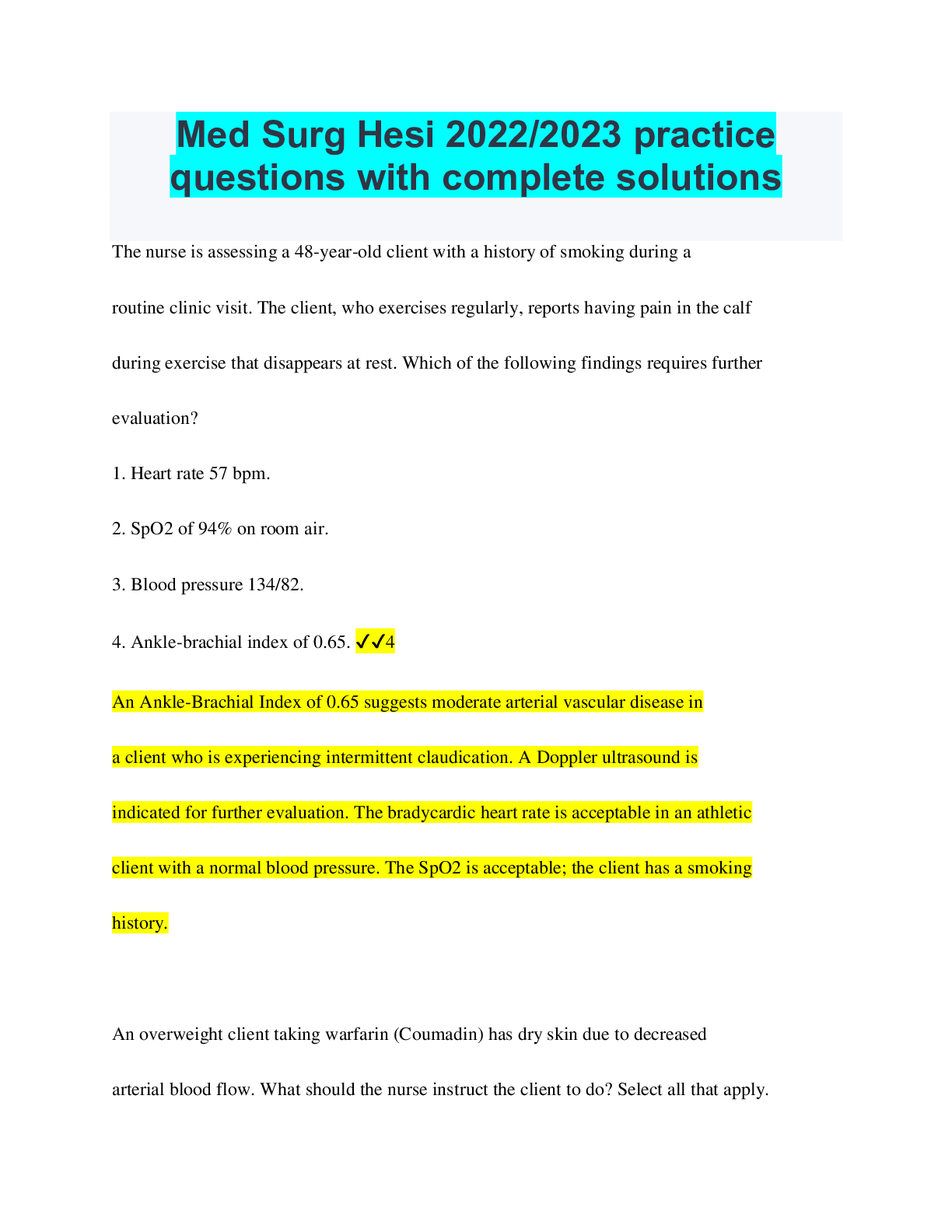


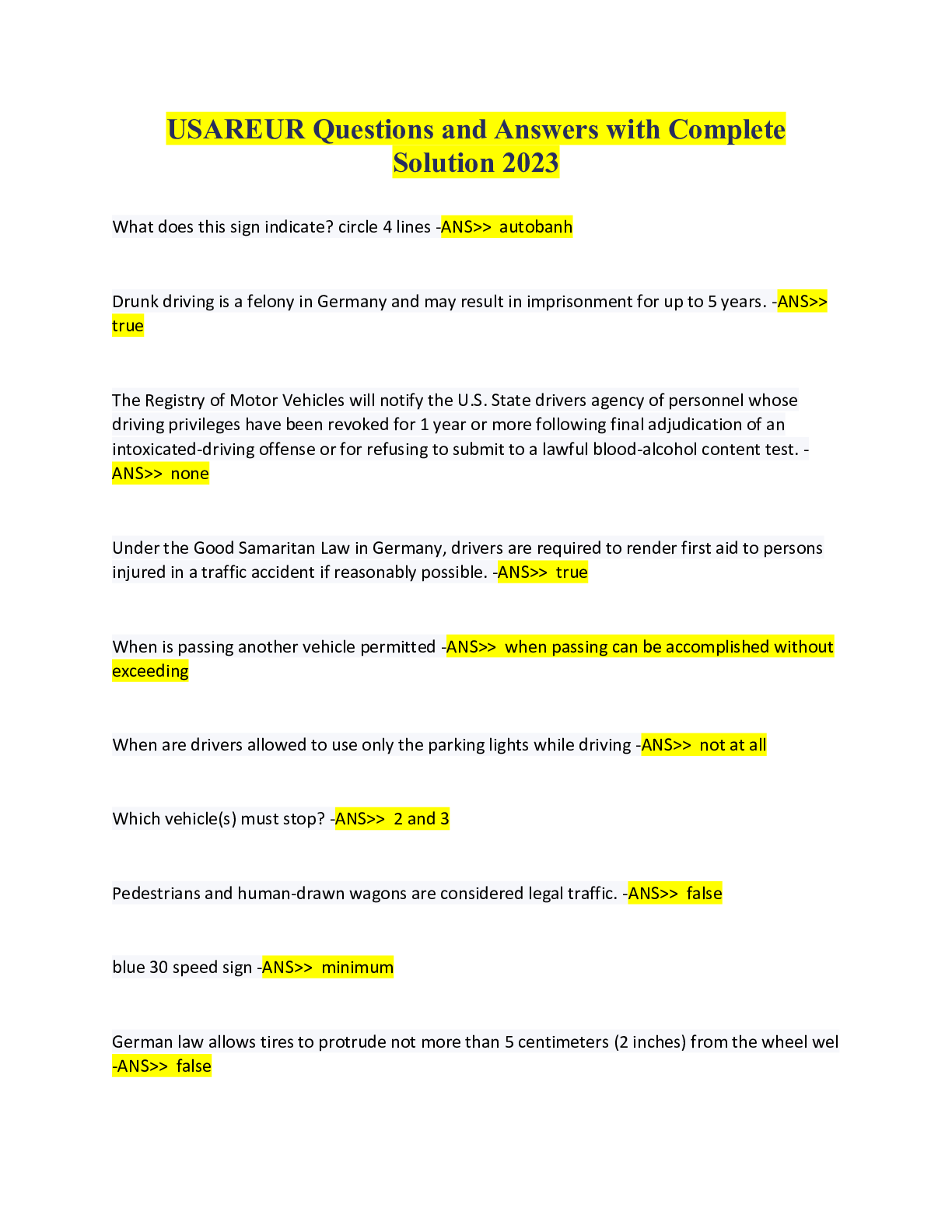

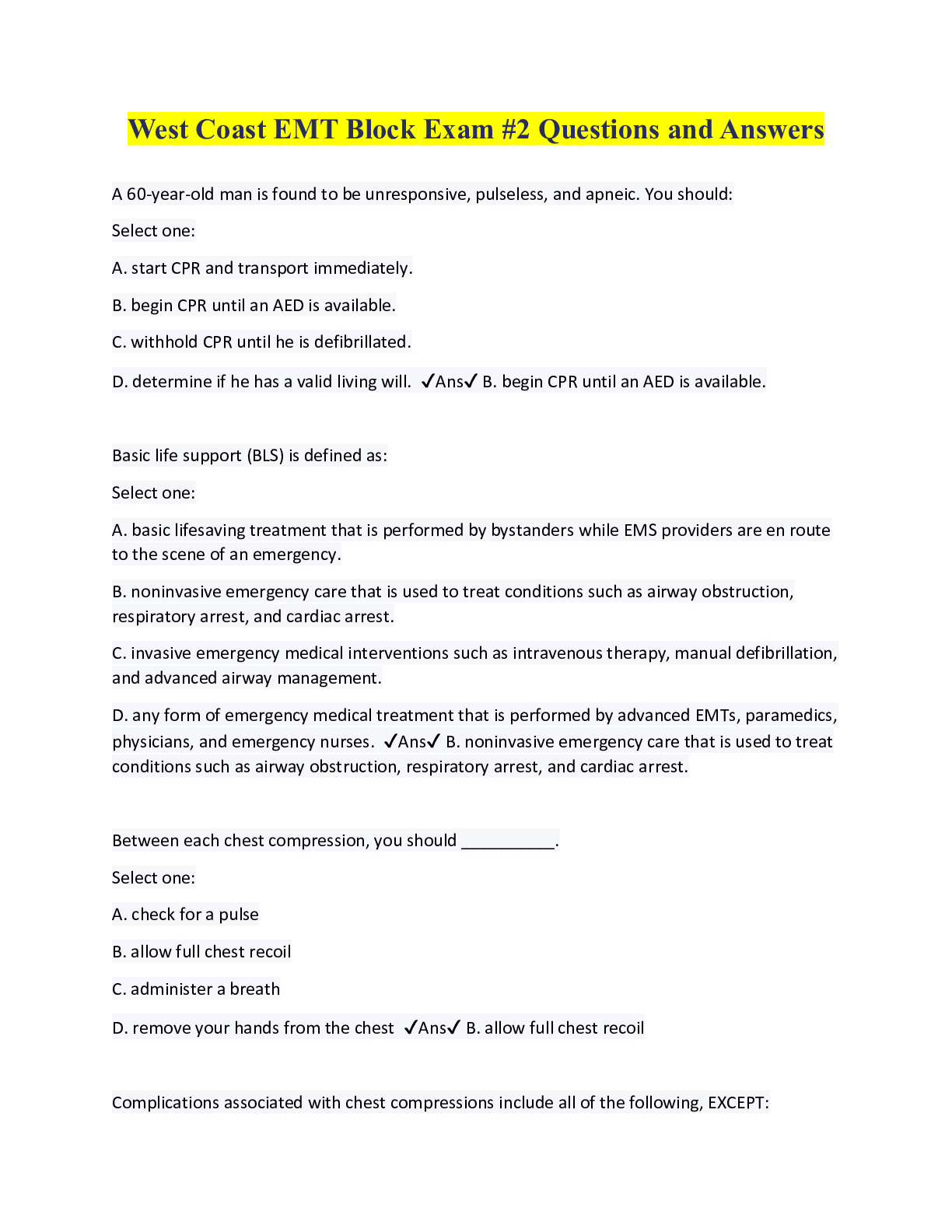
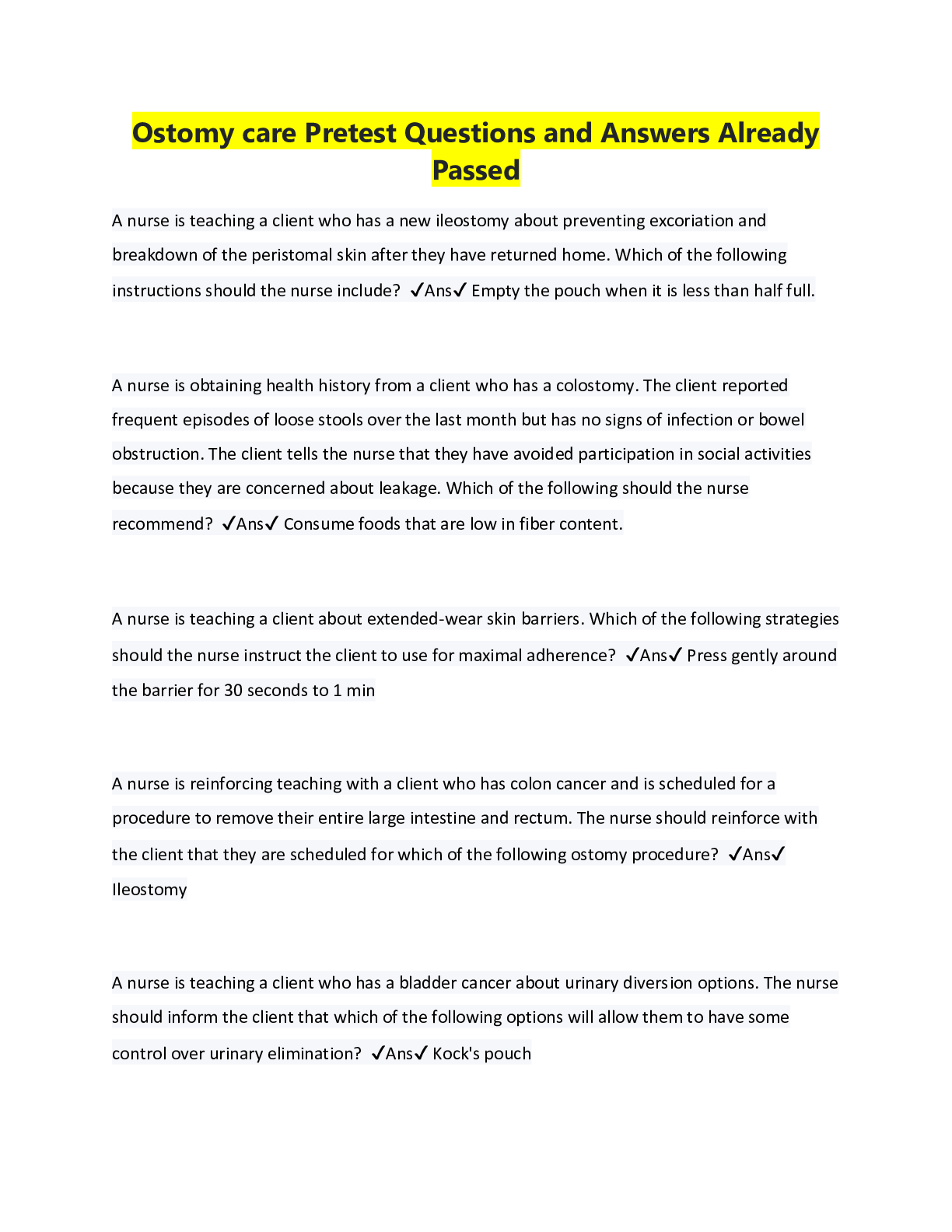
.png)
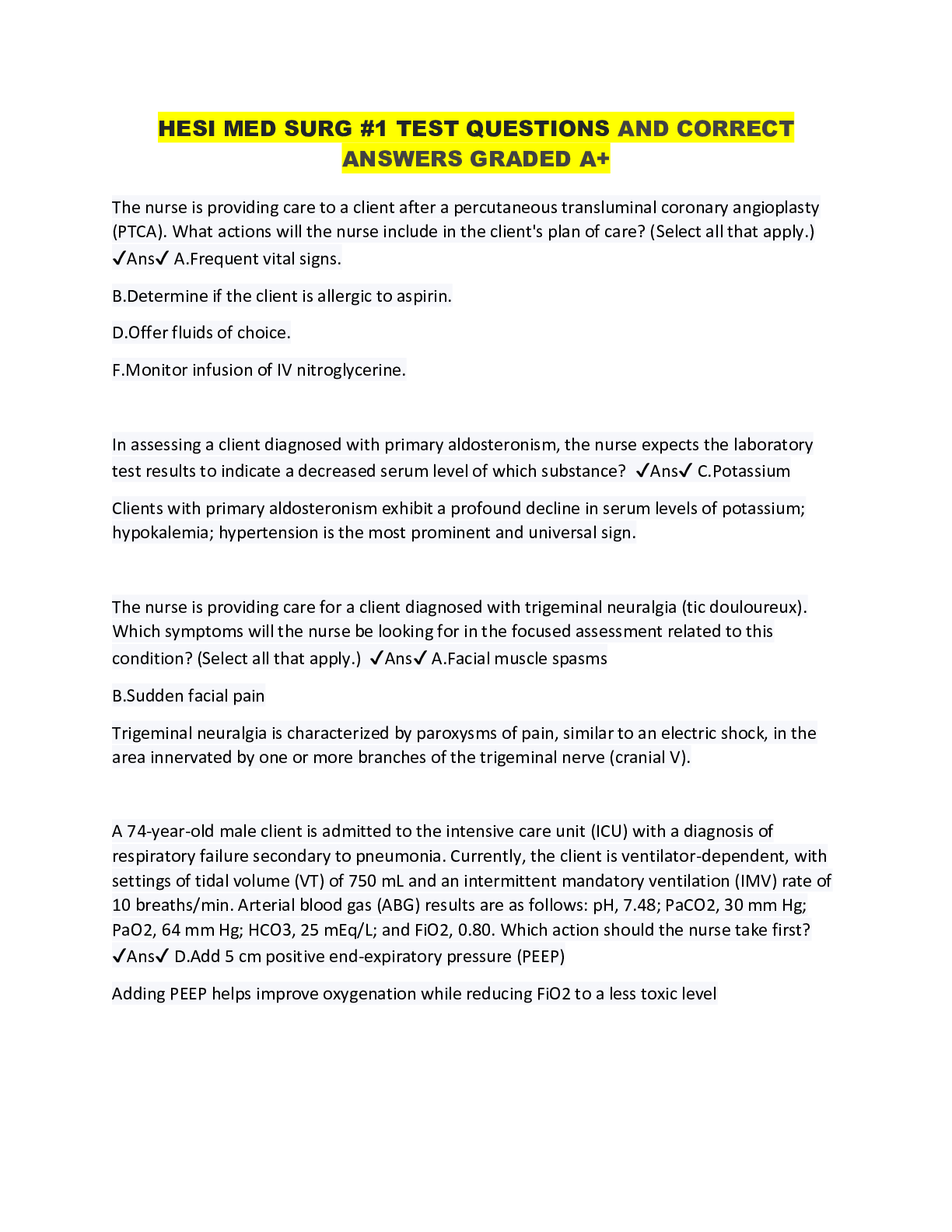


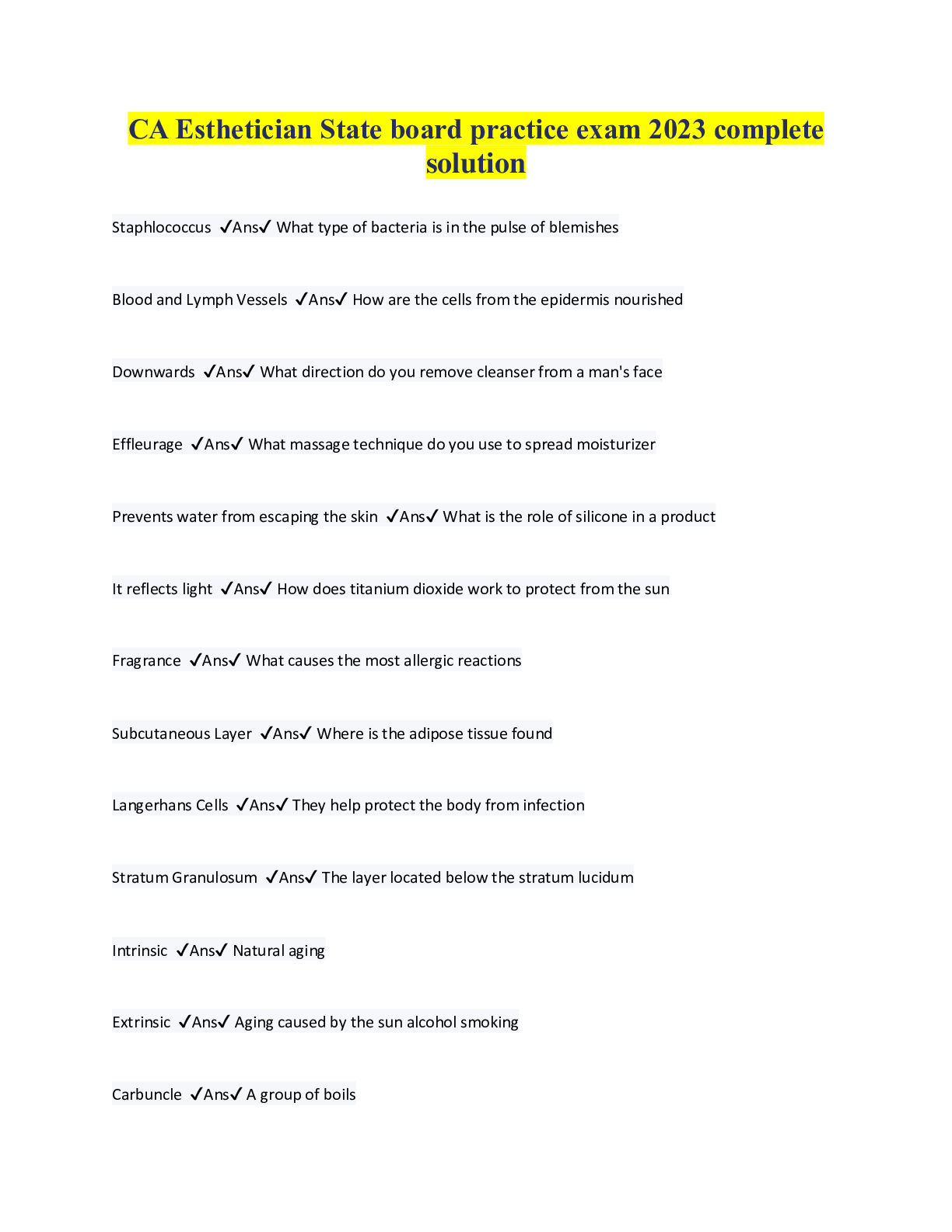
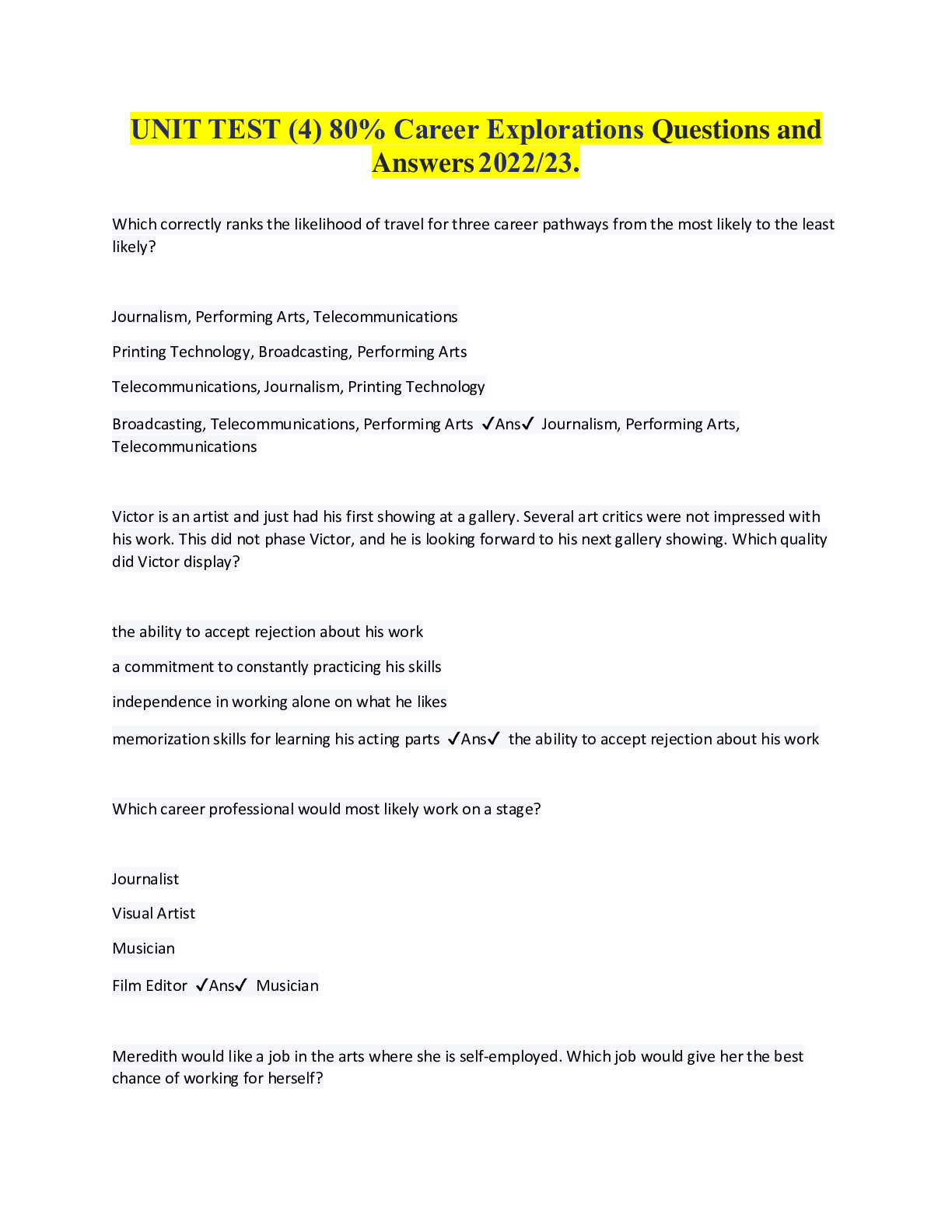
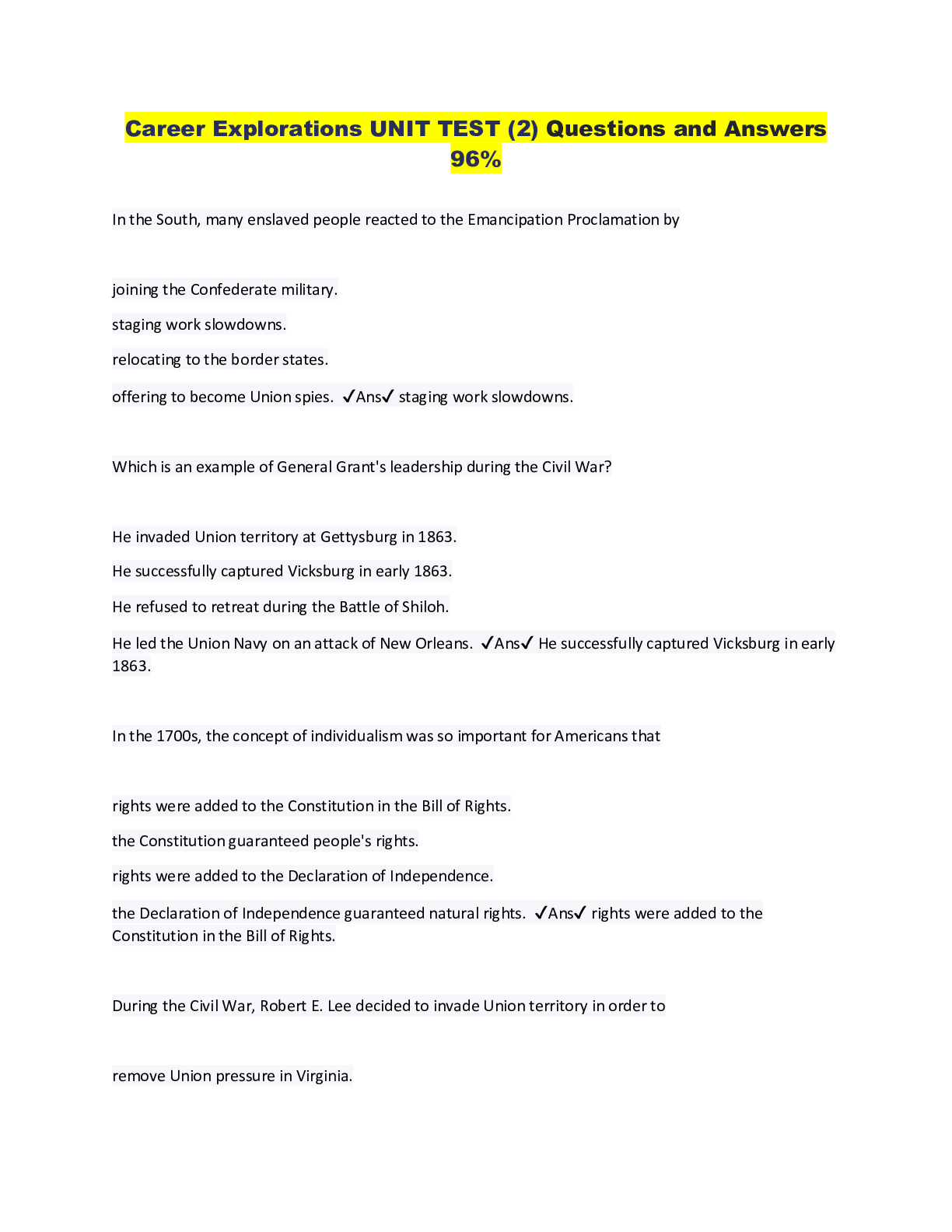
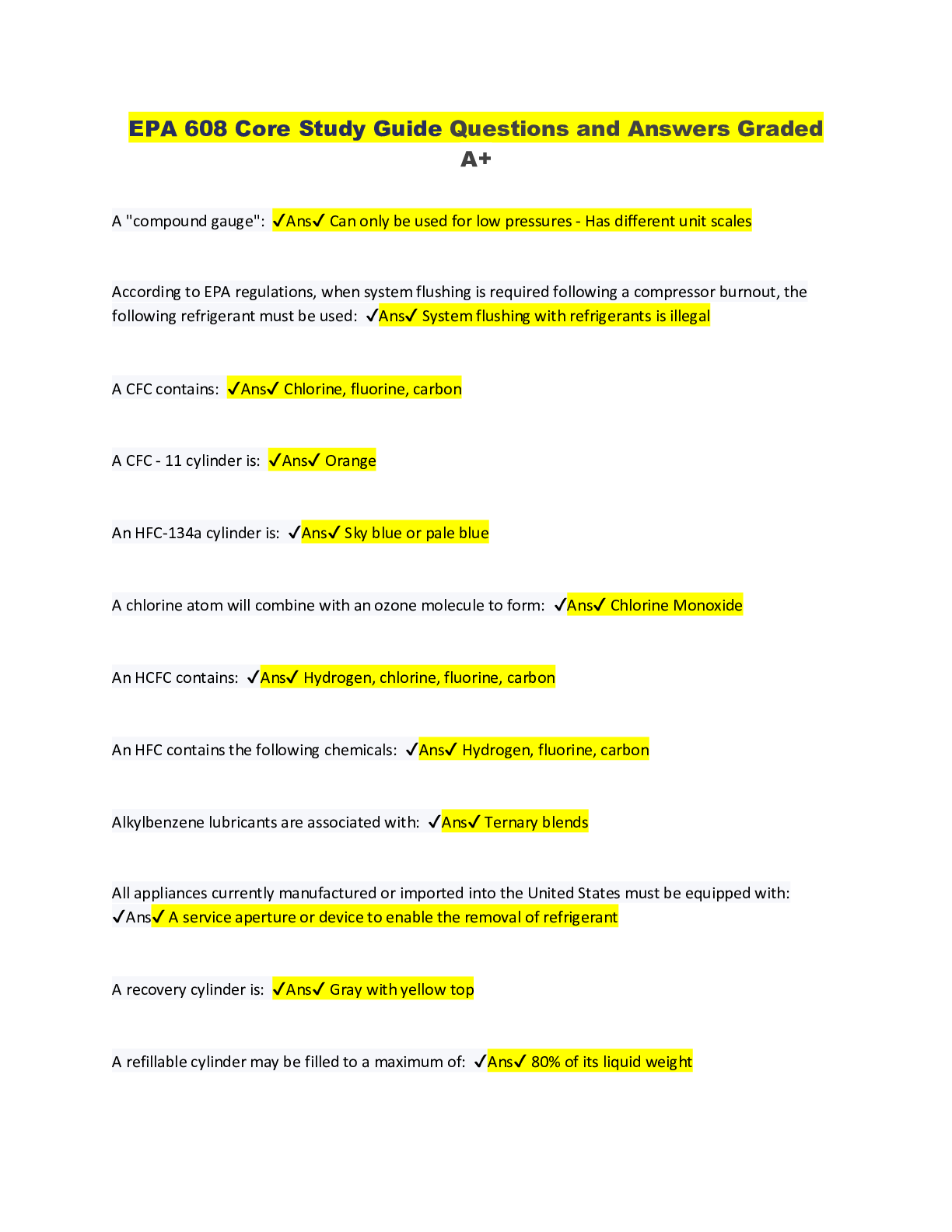

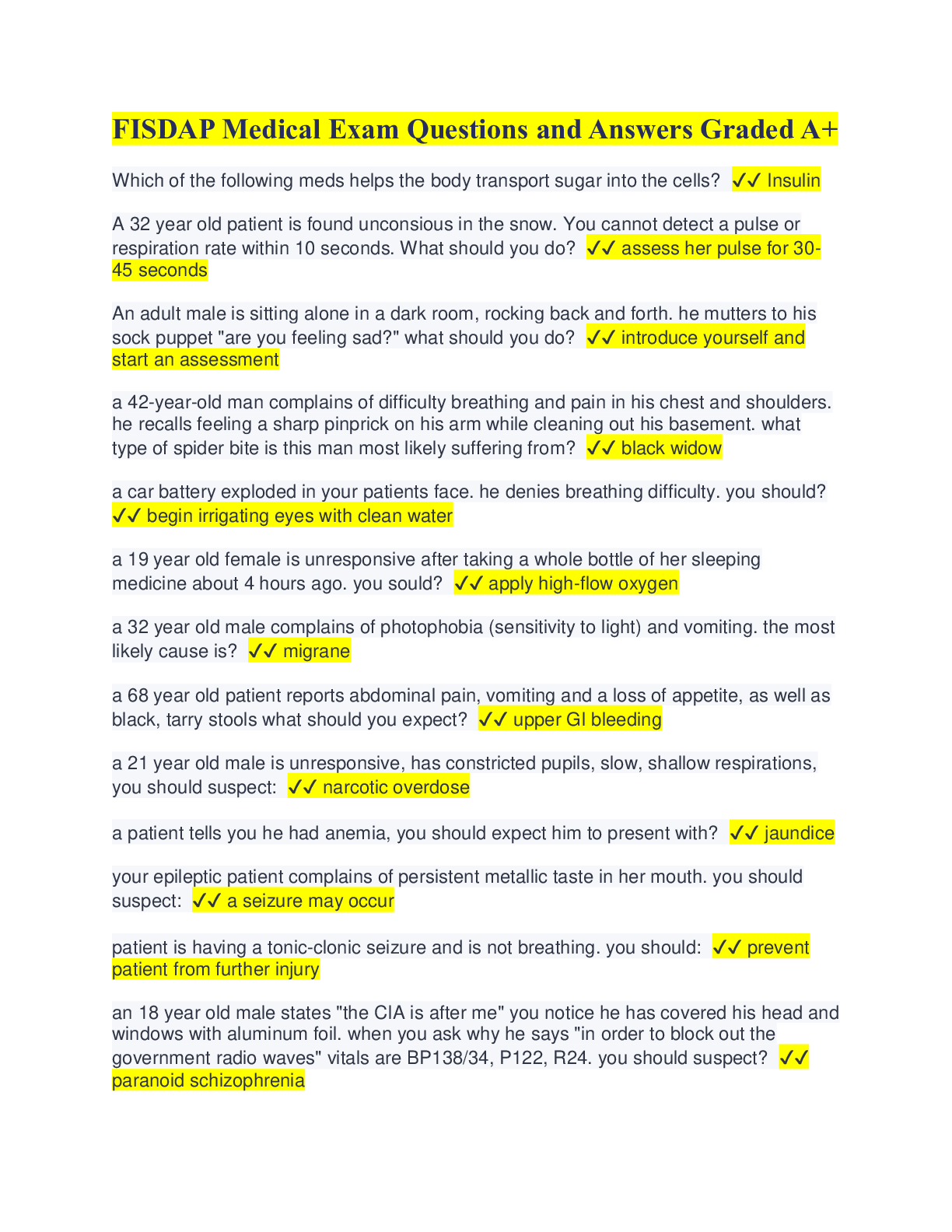

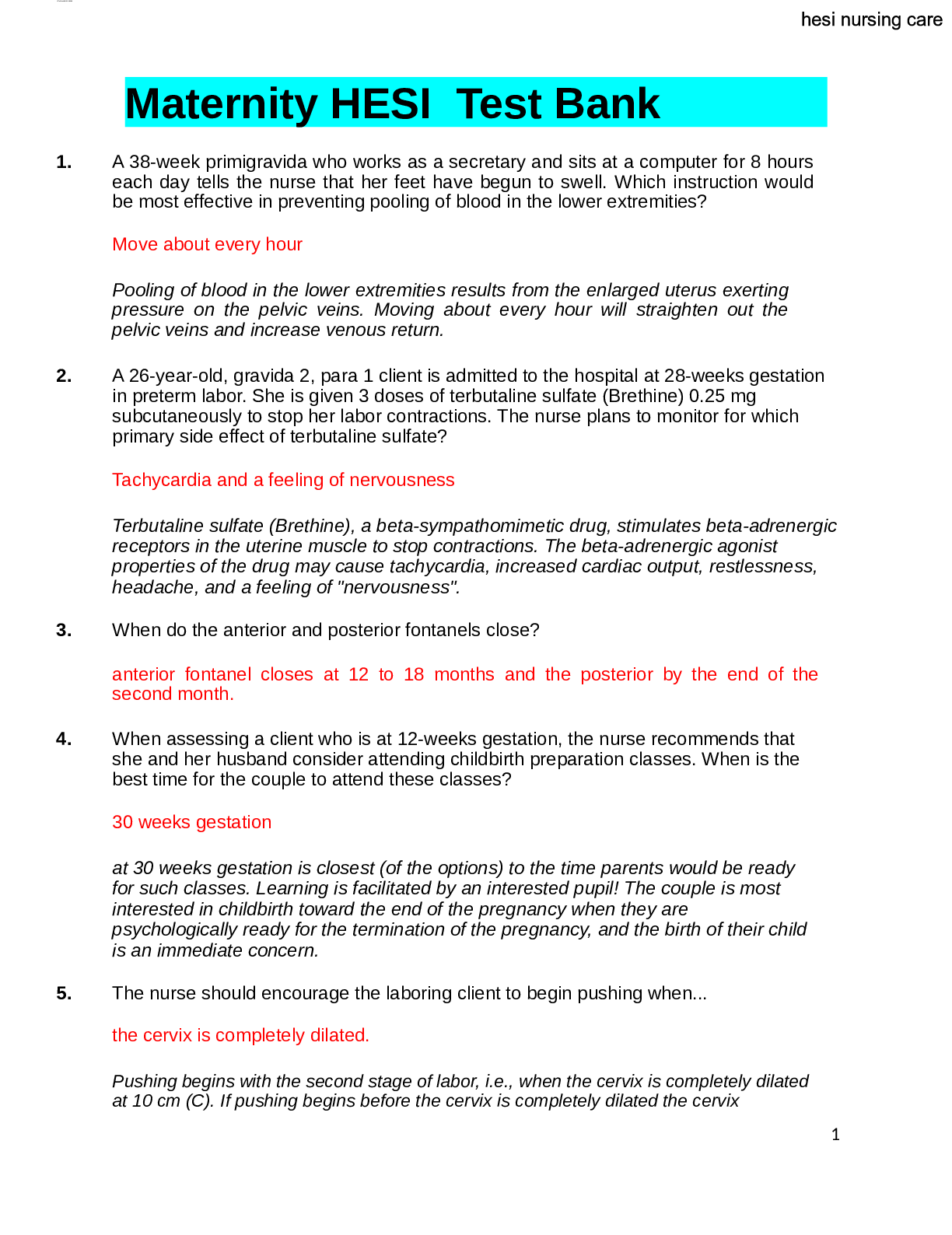
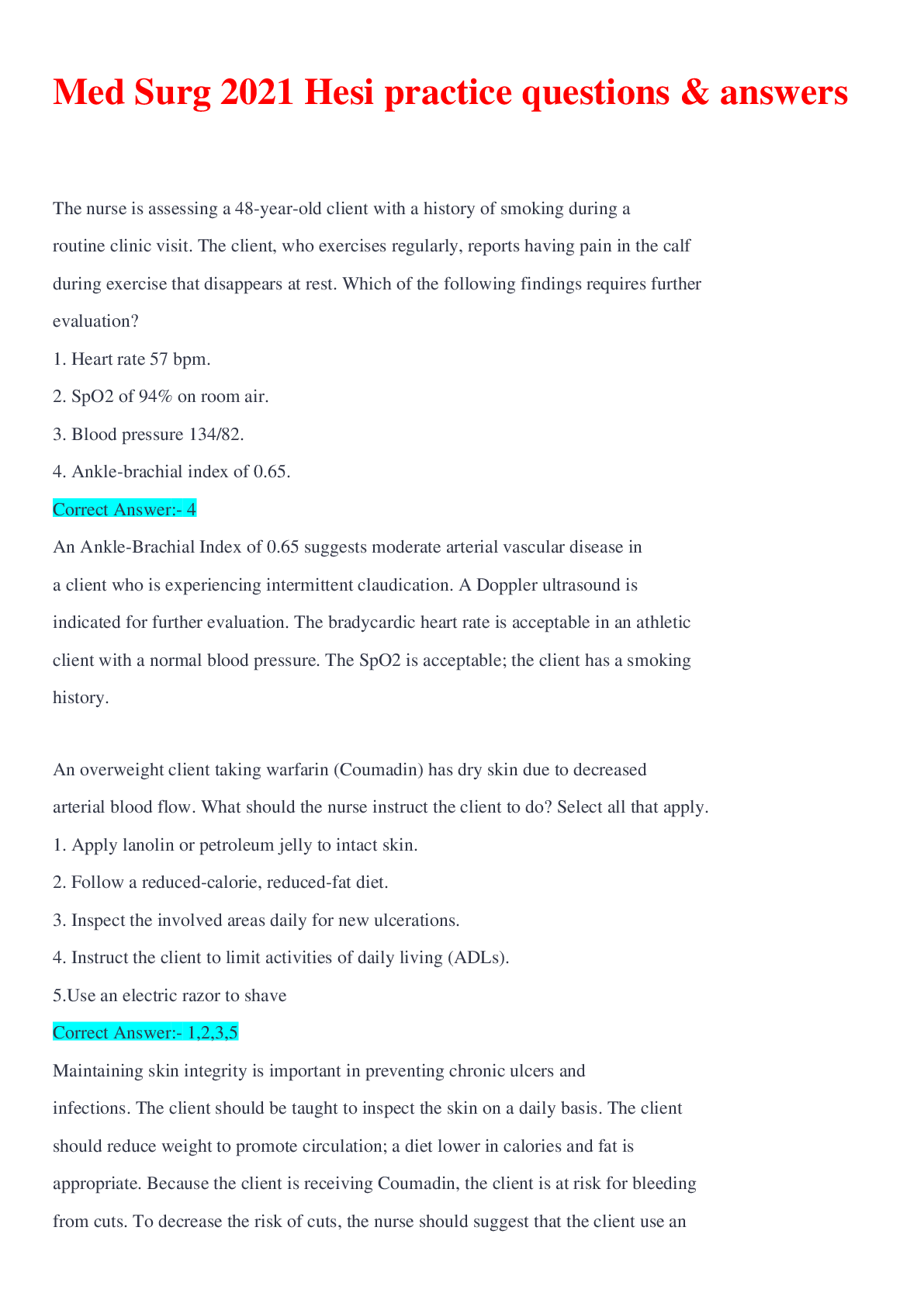
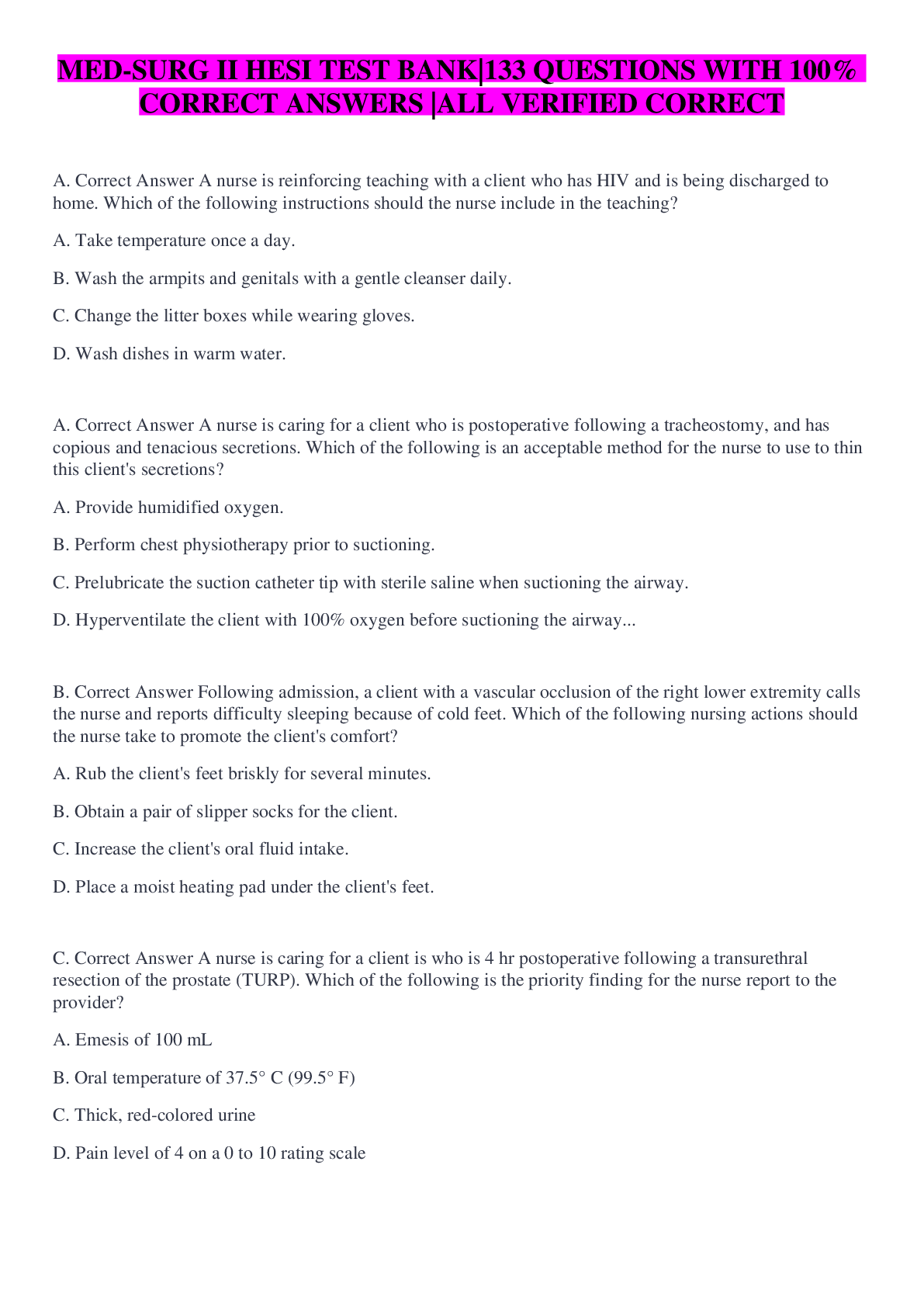
 TEST BANK RN Critical Care HESI TEST BANK RN Exam Elaborations Q&A (2021) Update.png)
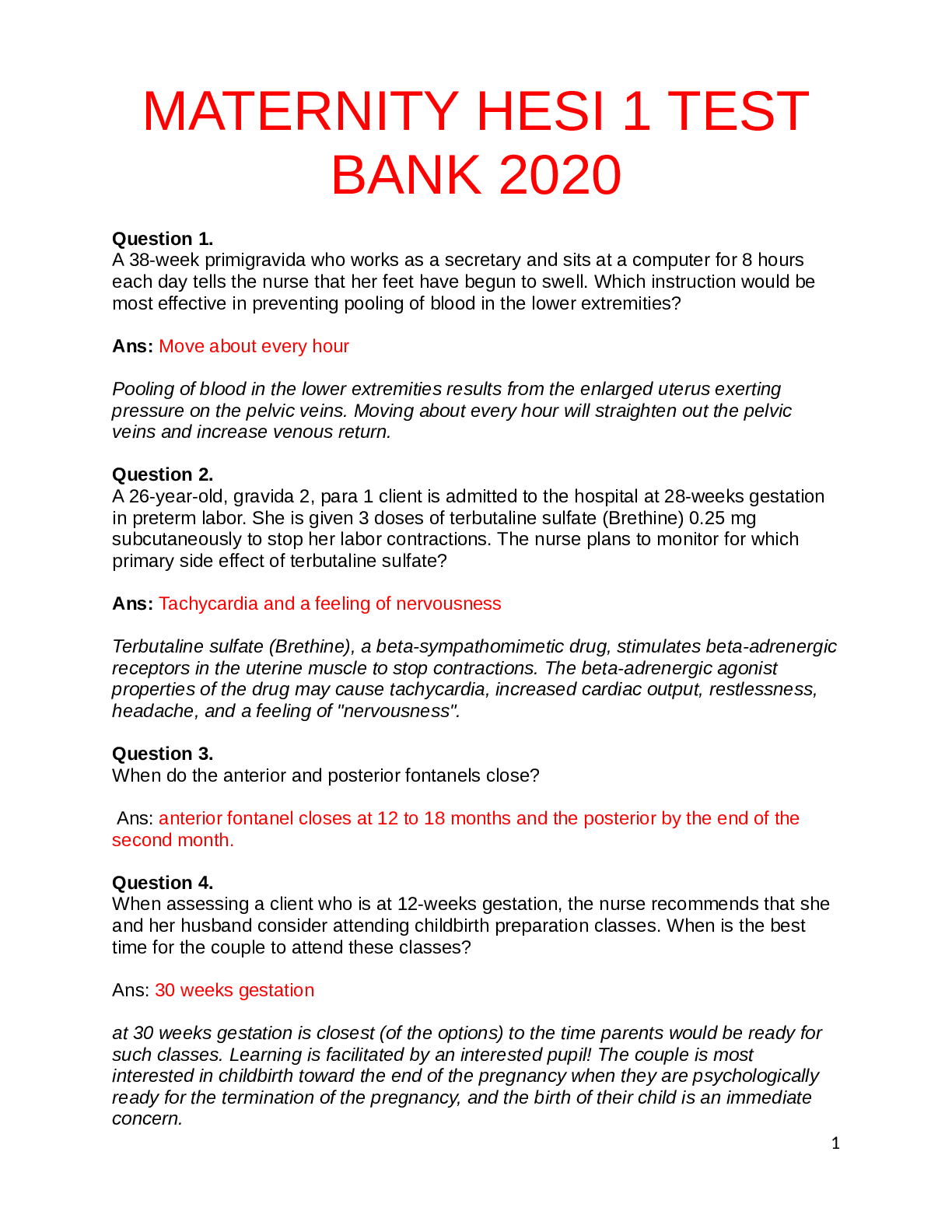

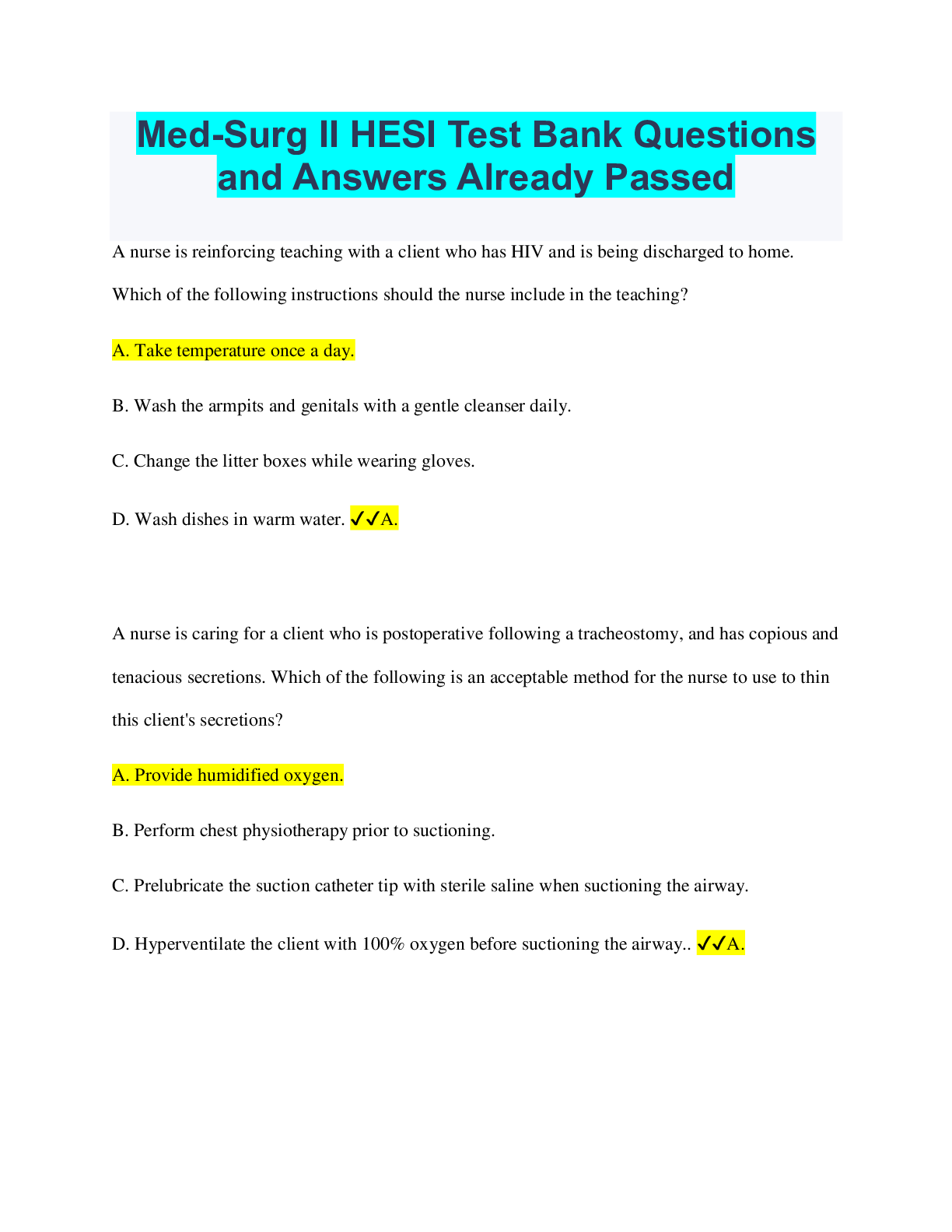

.png)
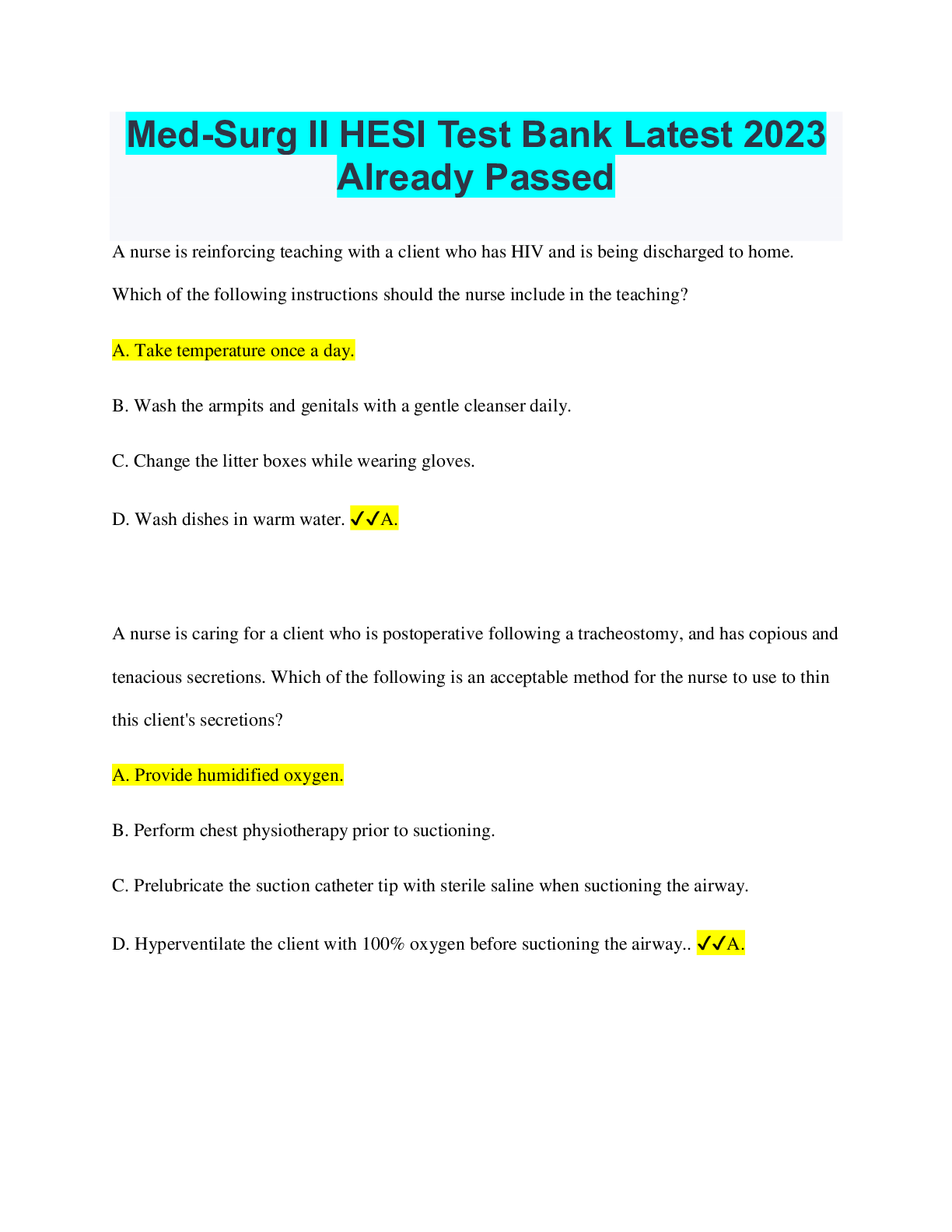
.png)
.png)
.png)

.png)
